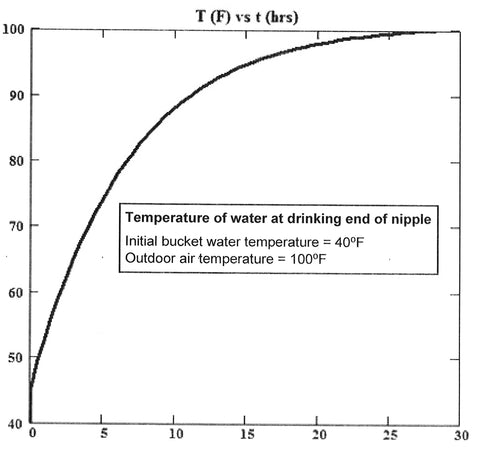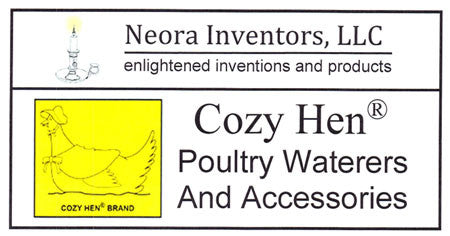In winter weather conditions:
- Temperature difference between the ‘drinking end’ of the nipple and the water in the bucket: about 8 ⁰F when the outside air temperature is 0 ⁰F and the water in the bucket is about 42 ⁰F
- Temperature vs. time after filling with warm water (105 ⁰F) and setting out in cold weather (0 ⁰F and 8 mph wind).
Without a heater, the initial fill of 105 ⁰F water (water at drinking end of nipple will be about 100⁰F or a little less) cools to about 40 ⁰F in about 10 hours when it’s 0 ⁰F outside and there’s an 8 mph wind. Then, the water at the drinking end of the nipple will be just above 32 ⁰F. If the average daytime temperature is higher, then it will take longer for the temperature of the drinking end of the nipple to fall to just above freezing.
With a heater, the water in the bucket is maintained above 73 ⁰F when it's about -7 ⁰F outside and the water at the drinking end of the nipple at or above 65⁰F. With outdoor temperature (averaged over more than a day) of about 0 ⁰F, the water in the bucket is maintained at 78 ⁰F, and the water at the drinking end of the nipple at about 70 ⁰F.
[The following curves are representative of approximate performance, and actual cooling and heating curves in your circumstances will depend on the air temperature and wind speed, both of which likely vary significantly throughout the day and night. The heat transfer coefficients for these calculations are based on experimental measurements in actual outdoor weather conditions. Our measurements span air temperatures from -7 ⁰F to 110 ⁰F, and wind speed up to about 20 mph with gusts to over 30 mph. For example, the curves for air temperature of 0 ⁰F and 8 mph wind agree with our measured cooling curves within experimental accuracy (error ≤ ±3 ° F). Of course, time to reach a specific temperature will vary as air temperatures fluctuate and wind speed varies.]


Cooling curve: temperature (⁰F) of water in bucket vs time (hrs) for an initial fill at 105 ⁰F and air temperature of 20 ⁰F and wind speed of about 8 mph. In this case, it typically takes about 16.5 hours for the water in the bucket to cool to about 40 ⁰F at which temperature, the drinking end of the nipple is at about freezing (32 ⁰F). If the initial fill temperature is about 90 ⁰F, then the time for the water in the bucket to reach 40 ⁰F is about 14 hours. With an initial fill temperature of about 90 ⁰F, it takes about 10 hours for the water in the bucket to cool to about 50 ⁰F. Of course, time to reach a specific temperature will vary as air temperature fluctuates and wind speed varies.

Cooling curve: temperature (⁰F) of water in bucket vs time (hrs) for an initial fill at 105 ⁰F and air temperature of 35 ⁰F and wind speed of about 8 mph. In this case, it typically takes about 19.6 hours for the water in the bucket to cool to about 50 ⁰F at which temperature, the drinking end of the nipple is at about freezing (44 ⁰F). If the initial fill temperature is about 90 ⁰F, then the time for the water in the bucket to reach 50 ⁰F is about 17 hours. Of course, time to reach a specific temperature will vary as air temperature fluctuates and wind speed varies.
In summer weather conditions:
- An initial fill with 40⁰F water, the water in the bucket will warm to about 90 ⁰F in about 11.5 hours when it"s 100⁰F outside. The drinking end of the nipple will be about 95 ⁰F. The water in the bucket will warm to about 85 ⁰F in about 8.5 hours, and the drinking end of the nipple will be at about 90 ⁰F. Because of its latent heat, the addition of some ice can slow the initial rate of heating. Of course, heating rate and time to reach a specific temperature will vary as air temperature fluctuates and wind speed varies.

